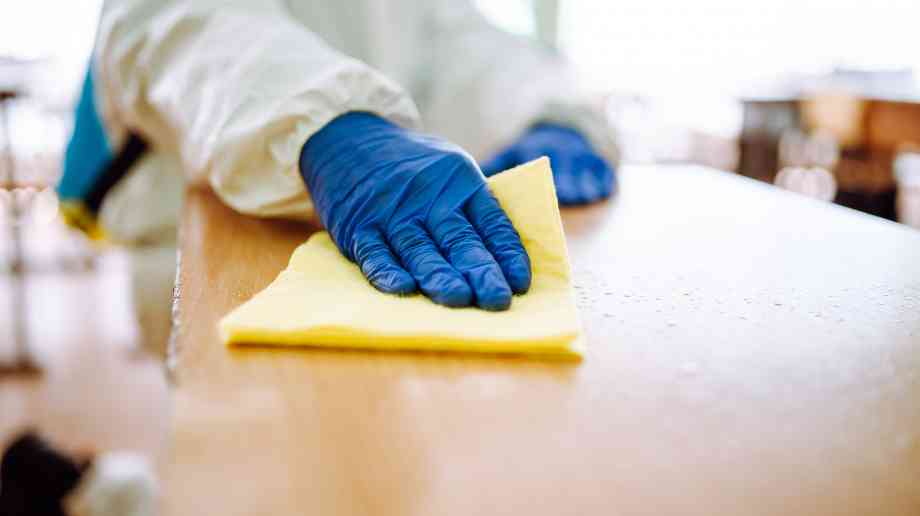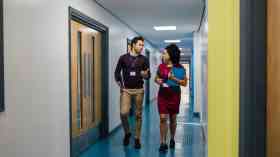
Cleaning in Covid times
Regular and enhanced cleaning, as well as extra hygiene measures from pupils and staff, play a vital role in limiting the transmission of Covid-19 in schools. We summarise the latest government advice
Cleaning and stricter hygiene measures have been a fundamental part of schools’ safe re-opening strategies.
Transmission of coronavirus (Covid-19) mainly occurs through respiratory droplets generated during breathing, talking, coughing and sneezing. This can happen when the droplets get onto and contaminate surfaces, which are then touched and introduced into the mouth or eyes of an uninfected person.
The infection risk from a Covid-19 contaminated environment decreases over time. It is not yet clear at what point there is no risk from the virus, however, studies suggest that, in non-healthcare settings, the risk of residual infectious virus is likely to be significantly reduced after 48 hours.
Extra hygiene measures and cleaning of surfaces and ‘touch points’ is therefore extremely important.
Schools are asked that everyone washes their hands more often than usual, particularly on arrival, when returning from breaks, when changing rooms, and before and after eating or handling food, as well as after touching your face, blowing your nose and sneezing or coughing.
Pupils and staff should be told to wash their hands thoroughly for 20 seconds with running water and soap and dry them thoroughly, or use alcohol hand rub/sanitiser ensuring that all parts of the hands are covered.
The ‘catch it, bin it, kill it’ approach to respiratory hygiene must be communicated to pupils and staff. This involves covering your mouth and nose with disposable tissues when you cough or sneeze. If one is not available, sneeze into the crook of your elbow, not into your hand. Dispose of tissues into a disposable rubbish bag and immediately clean your hands with soap and water or use a hand sanitiser.
The government’s guidance advises schools to enhance cleaning. This means more frequent cleaning of rooms or shared areas that are used by different groups, as well as frequently cleaning touched surfaces, such as door handles, handrails, play equipment, toys, and electronic devices (such as phones).
All education, childcare and children’s social care settings should follow the PHE guidance on cleaning for non-healthcare settings, which we summarise here.
Cleaning and disinfection
Regular cleaning plays a vital role in limiting the transmission of Covid-19. Reducing clutter and removing difficult to clean items can make cleaning easier. Increase the frequency of cleaning, using standard cleaning products such as detergents and bleach, paying attention to all surfaces but especially ones that are touched frequently, such as door handles, light switches, work surfaces, remote controls and electronic devices.
As a minimum, frequently touched surfaces should be wiped down twice a day, and one of these should be at the beginning or the end of the working day. Cleaning should be more frequent depending on the number of people using the space, whether they are entering and exiting the setting and access to handwashing and hand-sanitising facilities. Cleaning of frequently touched surfaces is particularly important in bathrooms and communal kitchens.
When cleaning surfaces, it is not necessary to wear personal protective equipment (PPE) or clothing over and above what would usually be used.
In bathrooms, frequently touched surfaces should be cleaned regularly. Ensure suitable hand washing facilities are available including running water, liquid soap and paper towels or hand driers. Where cloth towels are used, these should be for individual use and laundered in accordance with washing instructions.
Waste does not need to be segregated unless an individual in the setting shows symptoms of or tests positive for Covid-19.
Dispose of routine waste as normal, placing any used cloths or wipes in ‘black bag’ waste bins. You do not need to put them in an extra bag or store them for a time before throwing them away.
Cleaning after a confirmed case
If there is a confirmed case of Covid-19 in your school, the minimum PPE to be worn for cleaning is disposable gloves and an apron. Wash hands with soap and water for 20 seconds after all PPE has been removed.
If a risk assessment of the setting indicates that a higher level of virus may be present (for example, where someone unwell has spent the night (such as a boarding school dormitory) then additional PPE to protect the cleaner’s eyes, mouth and nose may be necessary.
Public areas where a symptomatic person has passed through and spent minimal time but which are not visibly contaminated with body fluids, such as corridors, can be cleaned thoroughly as normal.
All surfaces that the symptomatic person has come into contact with should be cleaned and disinfected, including all potentially contaminated and frequently touched areas such as bathrooms, door handles, telephones, grab rails in corridors and stairwells
Use disposable cloths or paper roll and disposable mop heads, to clean all hard surfaces, floors, chairs, door handles and sanitary fittings – think one site, one wipe, in one direction.
Cleaning can be done with either a combined detergent disinfectant solution at a dilution of 1,000 parts per million available chlorine (ppm av.cl.), or a household detergent followed by disinfection (1000 ppm av.cl.). Follow manufacturer’s instructions for dilution, application and contact times for all detergents and disinfectants. If an alternative disinfectant is used within the organisation ensure that it is effective against enveloped viruses.
Avoid mixing cleaning products together as this can create toxic fumes. Avoid creating splashes and spray when cleaning.
Any cloths and mop heads used must be disposed of and should be put into waste bags as outlined below.
When items cannot be cleaned using detergents or laundered, for example, upholstered furniture and mattresses, steam cleaning should be used.
Personal waste from individuals with symptoms of Covid-19 and waste from cleaning of areas where they have been (including PPE, disposable cloths and used tissues) should be put in a plastic rubbish bag and tied when full. The plastic bag should then be placed in a second bin bag and tied. This should be put in a suitable and secure place and marked for storage until the individual’s test results are known.
This waste should be stored safely and kept away from children. It should not be placed in communal waste areas until negative test results are known, or the waste has been stored for at least 72 hours.
If the individual tests negative, this can be put indisposed of immediately with the normal waste.
If Covid-19 is confirmed this waste should be stored for at least 72 hours before disposal with normal waste.
If during an emergency you need to remove the waste before 72 hours, it must be treated as Category B infectious waste. You must keep it separate from your other waste and arrange for collection by a specialist contractor as hazardous waste. There will be a charge for this service.
Read the government guidance here
Latest News
18/11/2025 - 09:28
Education Support, the charity dedicated to the mental health and wellbeing of teachers and education staff, has released its ninth Teacher Wellbeing Index.
17/11/2025 - 09:26
Nearly two thirds of Initial Teacher Training providers believe that teachers are not currently prepared to meet the government’s ambition to raise the complexity threshold for SEND pupils entering mainstream schools.
14/11/2025 - 11:04
England’s councils are warning of a "ticking time bomb" in the special educational needs and disabilities (SEND) system, with new data showing deficits that could bankrupt local authorities within three years.
13/11/2025 - 12:14
Event for school leaders, governors and education professionals relocates to the historic Old Billingsgate venue in London.
13/11/2025 - 09:49
The regulations have been set following a second consultation and detailed collaborative working with organisations and people across deaf and hearing communities.







